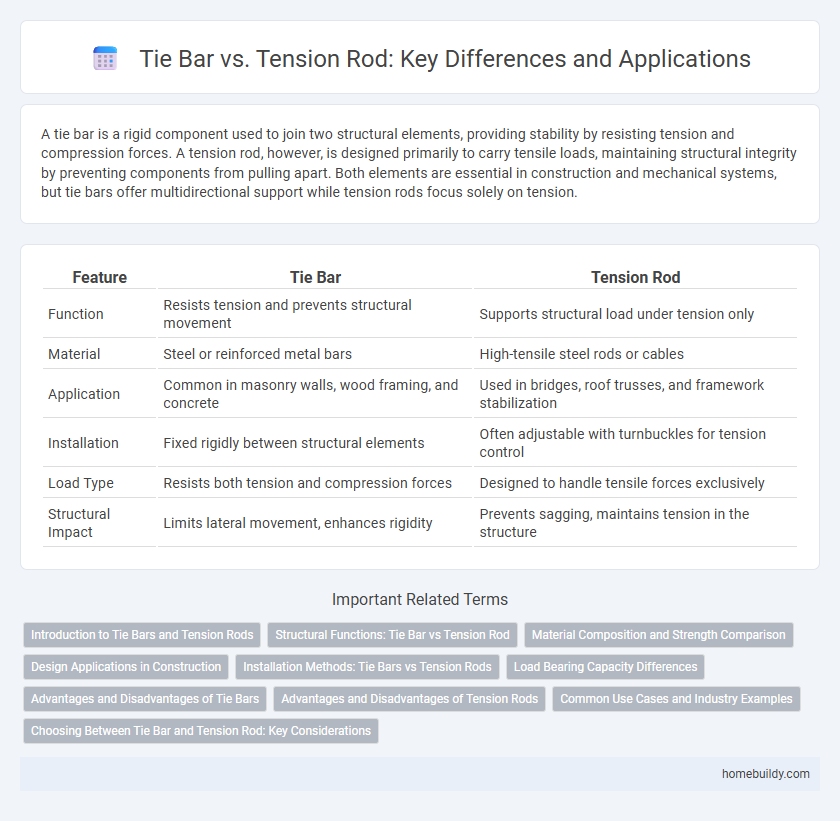A tie bar is a rigid component used to join two structural elements, providing stability by resisting tension and compression forces. A tension rod, however, is designed primarily to carry tensile loads, maintaining structural integrity by preventing components from pulling apart. Both elements are essential in construction and mechanical systems, but tie bars offer multidirectional support while tension rods focus solely on tension.
Table of Comparison
| Feature | Tie Bar | Tension Rod |
|---|---|---|
| Function | Resists tension and prevents structural movement | Supports structural load under tension only |
| Material | Steel or reinforced metal bars | High-tensile steel rods or cables |
| Application | Common in masonry walls, wood framing, and concrete | Used in bridges, roof trusses, and framework stabilization |
| Installation | Fixed rigidly between structural elements | Often adjustable with turnbuckles for tension control |
| Load Type | Resists both tension and compression forces | Designed to handle tensile forces exclusively |
| Structural Impact | Limits lateral movement, enhances rigidity | Prevents sagging, maintains tension in the structure |
Introduction to Tie Bars and Tension Rods
Tie bars and tension rods are structural components used to resist tensile forces in constructions and machinery. Tie bars are typically rigid steel bars that maintain alignment and provide stability, effectively preventing separation or movement between connected parts. Tension rods, on the other hand, are adjustable components designed to bear tensile loads, allowing fine-tuning of tension in systems like bridges and architectural frameworks.
Structural Functions: Tie Bar vs Tension Rod
Tie bars provide lateral support by resisting compressive forces and preventing buckling in structural elements, primarily stabilizing frameworks under load. Tension rods, in contrast, are designed to withstand tensile forces, maintaining structural integrity by holding components together under tension. The distinct mechanical roles of tie bars and tension rods optimize load distribution and enhance overall stability in construction applications.
Material Composition and Strength Comparison
Tie bars are commonly made from high-strength steel alloys known for their excellent tensile properties, providing superior durability and resistance to deformation under load. In contrast, tension rods may utilize materials such as carbon steel or stainless steel, which offer varying degrees of flexibility and corrosion resistance depending on specific alloy compositions. Overall, tie bars typically exhibit higher yield strength and stiffness compared to tension rods, making them preferable in applications requiring rigid structural support.
Design Applications in Construction
Tie bars and tension rods both serve critical roles in construction by providing structural reinforcement, but tie bars are typically used to resist tensile forces in concrete slabs and masonry walls, offering enhanced stability under shear stress. Tension rods are designed to carry axial tensile loads in truss systems and steel frame structures, delivering adjustable tension to maintain structural integrity. Selection between tie bars and tension rods depends on load requirements, environmental conditions, and specific design goals for reinforced concrete or steel frameworks.
Installation Methods: Tie Bars vs Tension Rods
Tie bars typically require embedding into concrete slabs or walls using anchor bolts or welded connections, ensuring a rigid and permanent installation for structural reinforcement. Tension rods, on the other hand, are often installed using adjustable turnbuckles or threaded end fittings, allowing for precise tension adjustment and flexibility in application. The installation of tie bars is generally more labor-intensive and permanent, whereas tension rods offer easier installation and maintenance due to their adjustable components.
Load Bearing Capacity Differences
Tie bars and tension rods differ significantly in load bearing capacity, with tie bars typically designed to resist compressive forces while tension rods primarily handle tensile loads. Tie bars provide enhanced structural stability by distributing both tension and compression, making them suitable for applications requiring balanced load management. Tension rods excel in applications where high tensile strength is critical, often supporting loads through slender, high-tensile steel components.
Advantages and Disadvantages of Tie Bars
Tie bars provide enhanced structural stability by effectively resisting lateral forces and distributing loads evenly across frameworks, which reduces material fatigue. Unlike tension rods that rely solely on tensile strength, tie bars perform well under both tension and compression, offering versatility in various construction applications. However, tie bars can be more complex to install and may require precise alignment and maintenance to prevent issues such as loosening or corrosion.
Advantages and Disadvantages of Tension Rods
Tension rods offer easy installation and adjustable tension control, making them ideal for applications requiring flexible support. However, their limitations include lower load capacity compared to tie bars and potential vulnerability to elongation under high stress. Unlike tie bars, tension rods may require more frequent maintenance to ensure structural integrity in dynamic environments.
Common Use Cases and Industry Examples
Tie bars are commonly used in construction and machinery to resist tensile forces and maintain structural alignment, particularly in concrete formwork and injection molding machines. Tension rods find frequent application in roofing systems, bridges, and reinforcing frameworks due to their ability to handle dynamic loads and provide adjustable tension. Industries such as civil engineering and automotive manufacturing rely heavily on tie bars for stability, while tension rods are prevalent in architectural supports and heavy equipment for their flexibility and load distribution.
Choosing Between Tie Bar and Tension Rod: Key Considerations
Choosing between a tie bar and a tension rod depends on load requirements and application specifics, where tie bars excel in distributing compressive forces while tension rods effectively handle tensile loads. Material strength, installation environment, and structural compatibility are critical factors influencing the decision, as tie bars are often preferred in rigid framework systems and tension rods in adjustable or dynamic settings. Evaluating these parameters ensures optimal performance in load-bearing applications, structural stability, and maintenance efficiency.
Tie bar vs Tension rod Infographic

 homebuildy.com
homebuildy.com